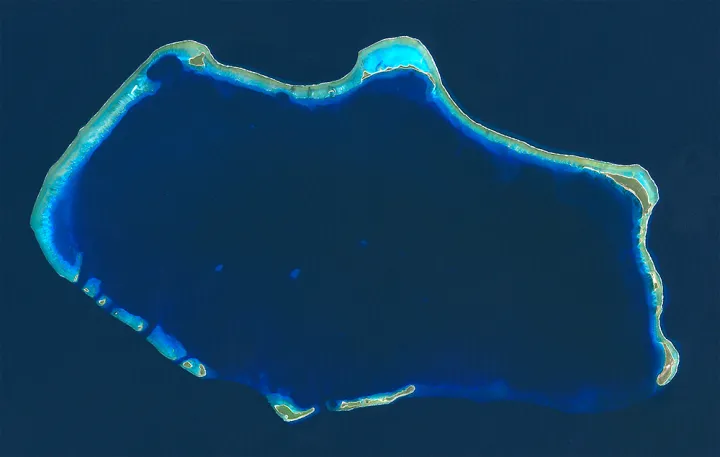Naturally Resilient

Coral Reefs Can Recover From Disasters. How Can We Save Them From Us?
Bikini Atoll, formed over millions of years around an island in the Pacific Ocean about halfway between Papua New Guinea and Hawaii, has been subjected to horrific human-caused disturbances. Between 1946 and 1958, the United States set off 23 separate nuclear explosions on or near the atoll to test the impacts of nuclear weapons on naval ships. The largest one, codenamed “Castle Bravo,” blasted a crater two kilometers wide and 73 meters deep into the reef on March 1, 1954, instantaneously raising the sea surface temperature to a staggering 55,000 degrees Celsius. (For comparison, the surface of the sun is a chilly 5,500 degrees Celsius.) While nobody took a comprehensive survey of reef life following these detonations (although Smithsonian researchers returned later), it‘s safe to say that nearby marine life would have died instantly as the blasts sterilized the seafloor.
In recent decades, radiation on Bikini Atoll has declined enough that it is safe for scientists to visit the reef and measure whether and how the corals have recovered. Despite the previous devastation, the reefs are thriving, have high coral cover, teem with fish, and most of the coral species have returned. This ability of an ecosystem to return to a similar ecological state following a disturbance is called resilience—and scientists are trying to figure out why some ecosystems can rebound, while others don’t recover
The natural world is in a constant state of change due to a myriad of disturbances large and small. Over decades, a typical reef might be exposed to daily changes in temperature and water chemistry, as well as periodic cyclones, disease outbreaks, and heat waves. Indeed, there may be so many disturbances that an observer might be surprised if a reef remains similar in appearance from year to year.
While Bikini Atoll has demonstrated remarkable resilience, many coral reefs have not fared nearly as well. Their unique life history explains why disturbances that seem less severe than a nuclear blast make reefs far less resilient over time.
Reef-building corals are both hunters and farmers, exquisitely adapted to living in shallow tropical waters that receive plenty of sunshine and contain few nutrients. They hunt using microscopic, poisonous harpoons called nematocysts—but usually only at night when there is more prey and fewer coral-eating animals to bite off their tentacles. Rather than sitting dormant during the day, corals shift to ”farming” with a remarkable twist: they cultivate microscopic algae on the inside of their clear bodies. In one of nature’s most elegant symbioses, corals feed their waste products to the algae, which the algae use to build sugars for themselves and for the coral to consume.
They use this energy to make rock out of water and build their home: the coral reef. The rock is calcium carbonate, which comprises the hard coral skeleton that corals live inside, and is made from dissolved calcium and carbon in a process called calcification. Together with a few other organisms like some kinds of algae and mollusks, corals build the three-dimensional structure of the reef, just like trees build the structure of the forest. However, corals take their work a step farther than trees and, over thousands of years, build entire islands and beaches. Indeed, Bikini Atoll would not exist were it not for the work of hard corals and other calcifiers.
Unfortunately, reef-building corals have been disappearing around the world due to a suite of disturbances that cause small amounts of harm every day. These slow, chronic disturbances—including higher temperatures, acidification, water pollution, and overfishing—change the environment to which corals are so well-adapted, making them less able to farm their algae for food and to deposit calcium carbonate. Thus weakened, they are more easily damaged by storms, disease, and competitors such as seaweeds
In isolation, none of these disturbances is anywhere near as devastating as a nuclear explosion, yet the sum total of their effects can prove to be much worse for corals over time. The key to understanding why so many of the world’s reefs are declining, while Bikini is flourishing, probably has to do with the frequency rather than magnitude of disturbance. When the bombing was done at Bikini, no one would visit for fear of radiation sickness. The island became a de-facto reserve where local disturbances from fishing and water pollution were minimized. In this environment, the reef recovered.
Managing for resilient coral reefs means finding ways to rethink the relationship between humans and coral reefs. The increasing concentration of carbon dioxide in the atmosphere from burning fossil fuels is warming ocean water, changing its chemistry, and may be creating more severe and frequent storms. All of these changes mean more frequent and more intense disturbances for reefs. For the reefs to flourish in the future, we need as a global community to reduce carbon dioxide emissions. In the meantime, there is a lot we can do at the local scale to build resilient coral reefs, such as protecting reef areas from fishing and reducing coastal pollution. These steps can go a long way to protect corals, while at the same time providing benefits to local communities. Such efforts are underway around the world.
As demonstrated by Bikini Atoll, coral reefs can be quite resilient—if we give them some breathing room.





